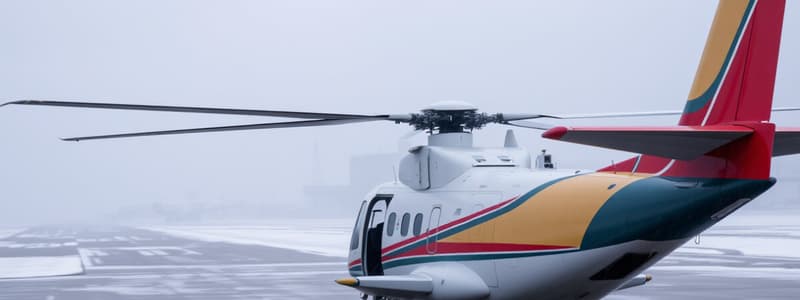Podcast
Questions and Answers
What is the Alert Height in relation to a Category III approach?
What is the Alert Height in relation to a Category III approach?
- Height above which the aircraft needs special clearance
- Height below which a landing is not permitted
- Height above the runway where a missed approach is required (correct)
- Height above ground for initiating a missed approach
What is defined as the specified altitude/height in a non-precision approach below which descent may not be made without visual reference?
What is defined as the specified altitude/height in a non-precision approach below which descent may not be made without visual reference?
- Obstacle Clearance Limit (OCL)
- Minimum Descent Altitude/Height (MDA/H) (correct)
- Missed Approach Point (MAPt)
- Obstacle Clearance Altitude/Height (OCA/H)
What characterizes a Category II (CAT II) operation?
What characterizes a Category II (CAT II) operation?
- Decision height below 200 ft but not lower than 100 ft (correct)
- Decision height lower than 50 ft
- Decision height not lower than 200 ft
- RVR not less than 550 m
What is the RVR requirement for Category III A (CAT III A) operations?
What is the RVR requirement for Category III A (CAT III A) operations?
In the context of an approach procedure, what must be initiated to ensure minimum obstacle clearance?
In the context of an approach procedure, what must be initiated to ensure minimum obstacle clearance?
Which of the following defines a Circling Approach?
Which of the following defines a Circling Approach?
What encompasses the use of precision azimuth and glide path guidance in an instrument approach?
What encompasses the use of precision azimuth and glide path guidance in an instrument approach?
Which statement is true regarding Category III B (CAT III B) operation?
Which statement is true regarding Category III B (CAT III B) operation?
What is meant by Required Visual Reference during an approach?
What is meant by Required Visual Reference during an approach?
What does the term Low Visibility Operations (LVO) specifically refer to?
What does the term Low Visibility Operations (LVO) specifically refer to?
What is the primary factor in determining the category of an operation?
What is the primary factor in determining the category of an operation?
In CAT II operations, what is the minimum RVR requirement?
In CAT II operations, what is the minimum RVR requirement?
What is the Obstacle Clearance Altitude/Height (OCA/H)?
What is the Obstacle Clearance Altitude/Height (OCA/H)?
What is the maximum Runway Visual Range (RVR) required for conducting a visual approach?
What is the maximum Runway Visual Range (RVR) required for conducting a visual approach?
How is the cloud base defined?
How is the cloud base defined?
Which of the following describes a Non-Precision Approach and Landing Operation?
Which of the following describes a Non-Precision Approach and Landing Operation?
What technique does AEROTRANSCARGO use for Non-Precision Approaches?
What technique does AEROTRANSCARGO use for Non-Precision Approaches?
What is the purpose of the Obstacle Clearance Limit (OCL)?
What is the purpose of the Obstacle Clearance Limit (OCL)?
What additional height is added to all chart minima for Non-Precision Approaches by AEROTRANSCARGO?
What additional height is added to all chart minima for Non-Precision Approaches by AEROTRANSCARGO?
What is the required visual reference for descent below the Minimum Descent Altitude (MDA) during a non-precision approach?
What is the required visual reference for descent below the Minimum Descent Altitude (MDA) during a non-precision approach?
How are operating minima for CAT I approaches determined?
How are operating minima for CAT I approaches determined?
Which approaches allow for the use of chart minima without adding additional height as per AEROTRANSCARGO policy?
Which approaches allow for the use of chart minima without adding additional height as per AEROTRANSCARGO policy?
What does RVR stand for in aviation terminology?
What does RVR stand for in aviation terminology?
What is prohibited during a visual approach if the RVR is below the minimum requirement?
What is prohibited during a visual approach if the RVR is below the minimum requirement?
What is included in the LVO Approach briefing that differs from a standard IFR arrival briefing?
What is included in the LVO Approach briefing that differs from a standard IFR arrival briefing?
Which of the following is NOT a focus during the LVO Approach briefing?
Which of the following is NOT a focus during the LVO Approach briefing?
What is a potential risk of using landing lights at night in low visibility?
What is a potential risk of using landing lights at night in low visibility?
What primary task does the Pilot Flying (PF) have during the approach?
What primary task does the Pilot Flying (PF) have during the approach?
At what point does the Commander assess the visual references during an approach with a Decision Height (DH)?
At what point does the Commander assess the visual references during an approach with a Decision Height (DH)?
Which procedure should be reviewed during the LVO Approach briefing?
Which procedure should be reviewed during the LVO Approach briefing?
What could significantly affect the visual segment while landing?
What could significantly affect the visual segment while landing?
What should the Pilot Not Flying (PNF) primarily monitor during an approach?
What should the Pilot Not Flying (PNF) primarily monitor during an approach?
What is the minimum number of consecutive lights required for a pilot to continue an approach in Category IIIA operations?
What is the minimum number of consecutive lights required for a pilot to continue an approach in Category IIIA operations?
For Category IIIB operations with fail-operational flight control systems, what must a pilot maintain visibility of to continue an approach?
For Category IIIB operations with fail-operational flight control systems, what must a pilot maintain visibility of to continue an approach?
What is the visibility requirement for using aerodromes for LVOs?
What is the visibility requirement for using aerodromes for LVOs?
Which of the following is NOT required for Category III operations with no decision height?
Which of the following is NOT required for Category III operations with no decision height?
What equipment is primarily used to measure runway visual range (RVR)?
What equipment is primarily used to measure runway visual range (RVR)?
Which of the following conditions must be met for an aerodrome to be utilized for LVOs below a visibility of 800 m?
Which of the following conditions must be met for an aerodrome to be utilized for LVOs below a visibility of 800 m?
In Category IIIA operations, which of the following lights could satisfy the required visual reference?
In Category IIIA operations, which of the following lights could satisfy the required visual reference?
Under what circumstances can a pilot not continue an approach in Category IIIB operations?
Under what circumstances can a pilot not continue an approach in Category IIIB operations?
Study Notes
All Weather Operations Overview
- Alert Height: Above this height on approach, a Category III operation must abort if an aircraft failure occurs.
- Categories of Operations:
- Category I (CAT I): Decision height ≥ 200 ft with RVR ≥ 550 m.
- Category II (CAT II): Decision height 100-200 ft and RVR ≥ 300 m.
- Category III (CAT III):
- CAT III A: Decision height < 100 ft and RVR ≥ 200 m.
- CAT III B: Decision height < 50 ft or none, RVR between 75 m and 200 m.
- Non-Precision Approach: Any approach that does not use electronic glide path guidance.
Terminology Key Points
- Low Visibility Operations (LVO): Media term for operations at RVR < 400 m.
- Minimum Descent Altitude/Height (MDA/H): Lowest altitude for visual reference in non-precision or circling approaches.
- Missed Approach Point (MAPt): Point in an approach where missed approach must begin for safe obstacle clearance.
Operating Minima
- Non-Precision Approaches: AEROTRANSCARGO applies CDFA technique and adds 50 ft to all minima except for ILS and Circling approaches.
- CAT I Approaches: Minima determined per specific operational paragraph guidelines.
Required Visual References
- Visual references are crucial for descending safely during approaches:
- For non-precision approaches: Follow designated reference guidelines.
- For CAT I approaches: Specific visual references must be maintained below Decision Altitude (DA).
Aerodrome Requirements for LVO
- Use of an aerodrome for LVO below 800 m visibility requires State approval and established Low Visibility Procedures (LVP).
Runway Visual Range (RVR) Requirements
- RVR is measured using calibrated transmissometers considering environmental effects; operations should not commence without clearance.
LVO Approach Briefing Essentials
- Must include weather assessment, aircraft systems review, task distribution, and procedure for potential downgrading scenarios.
- Emphasize optimal seat position and autopilot settings for safety.
Use of Aircraft Lights
- In low visibility, landing lights may reduce visual references; their use is discouraged during CAT II and CAT III conditions.
Aircraft Operating Procedures
- Pilot Flying (PF) focuses on managing approaches; Pilot Not Flying (PNF) monitors systems and advises on abnormalities.
- Detailed standard operating procedures, including coordinated calls and techniques, are referenced in Operations Manual Part B.
Acquisition of Visual References
- Decision Height (DH) indicates the limit where visual references are evaluated; preparedness for a go-around must be maintained without bias prior to reaching DH.
Studying That Suits You
Use AI to generate personalized quizzes and flashcards to suit your learning preferences.
Related Documents
Description
Explore the critical aspects of Chapter 8 from the Operations Manual Part A, focusing on All Weather Operations. This section outlines key terminology and procedures essential for safe flight operations under various weather conditions. Gain a deeper understanding of alert heights and other operational details.



